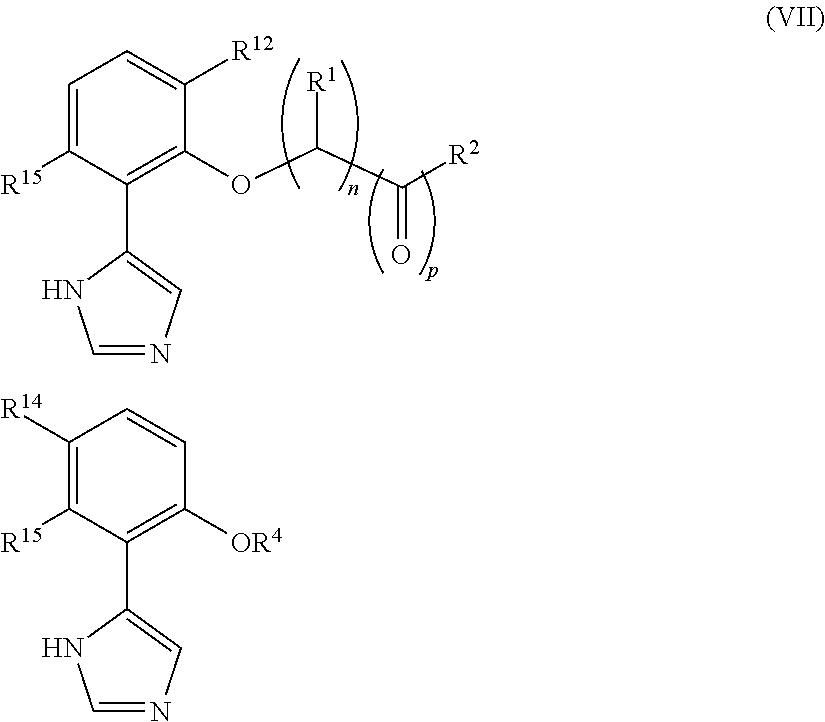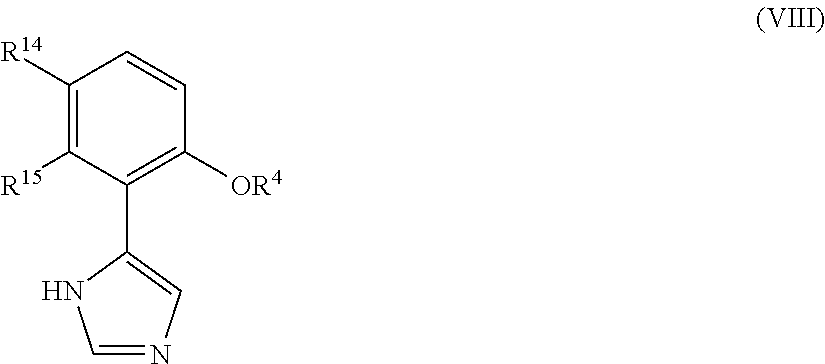Imidazole Derivatives as IDO Inhibitors
a technology of indoleamine and derivatives, which is applied in the direction of biocide, drug composition, immunological disorders, etc., can solve the problem that the fetus cannot fully explain the survival of fetal allografts
- Summary
- Abstract
- Description
- Claims
- Application Information
AI Technical Summary
Problems solved by technology
Method used
Image
Examples
example 1
2-(4-(2-Hydroxyethyl)phenyl)isoindoline-1,3-dione
[0501]
[0502]A flask containing 4-aminophenethyl alcohol (1 g, 7.29 mmol), phthalic anhydride (1.13 g, 7.65 mmol) and acetic acid (6 mL) was heated at 100° C. for 1 h. The reaction mixture was poured into water (50 mL) and the solid was filtered off and washed with water. The crude was purified by flash column chromatography to afford the desired product as white solid (1.2 g, 62%). 1H NMR: 2.92 (t, 2H, J=6.6 Hz), 3.89 (t, 2H, J=6.6 Hz), 7.38 (s, 3H), 7.77-7.82 (m, 2H), 7.92-7.97 (m, 21-1).
example 2
4-(1,3-Dioxoisoindolin-2-yl)phenethyl 4-methylbenzenesulfonate
[0503]
[0504]2-(4-(2-hydroxyethyl)phenyl)isoindoline-1,3-dione (926 mg, 3.46 mmol) was dissolved in dichloromethane (15 mL), cooled to 0° C. and p-toluenesulfonyl chloride (991 mg, 5.2 mmol) was added, followed by pyridine (0.56 ml, 6.93 mmol). The reaction was stirred at room temperature for 16 h and concentrated. The residue was dissolved in ethyl acetate (60 ml), washed with water (20 ml), saturated aqueous NaHCO3 (2×15 ml), brine (20 mL), dried over sodium sulfate, filtered and concentrated. The crude tosylate was used without further purification.
example 3
4-(2-(2-(1-Trityl-1H-imidazol-4-yl)phenoxy)ethyl)aniline
[0505]
[0506]To a solution of the 2-(1-trityl-1H-imidazol-4-yl)phenol (1.1 g, 2.73 mmol) in DMF (15 mL) was added NaH (83 mg, 3.28 mmol) at 0° C. and the mixture was stirred at room temperature for 1 h. 4-(1,3-dioxoisoindolin-2-yl)phenethyl 4-methylbenzenesulfonate (1.15 g, 2.73 mmol) was added to the mixture. After stirring overnight under a nitrogen atmosphere, the reaction mixture was diluted with water (10 mL) and extracted with ethyl acetate (2×30 mL). The combined organic layers were washed with water (2×20 mL), brine (20 mL) and dried. The solvent was removed under reduced pressure and, the crude product was dissolved in ethanol (15 mL) and treated with hydrazine hydrate (0.3 mL, 5.46 mmol). The mixture was heated at 80° C. for 2 h and filtered. The solvent was removed under reduced pressure and the residue was purified by flash column chromatography (silica gel, 30%-50% EtOAc / hexanes as eluent) to afford the desired prod...
PUM
 Login to View More
Login to View More Abstract
Description
Claims
Application Information
 Login to View More
Login to View More - R&D
- Intellectual Property
- Life Sciences
- Materials
- Tech Scout
- Unparalleled Data Quality
- Higher Quality Content
- 60% Fewer Hallucinations
Browse by: Latest US Patents, China's latest patents, Technical Efficacy Thesaurus, Application Domain, Technology Topic, Popular Technical Reports.
© 2025 PatSnap. All rights reserved.Legal|Privacy policy|Modern Slavery Act Transparency Statement|Sitemap|About US| Contact US: help@patsnap.com



